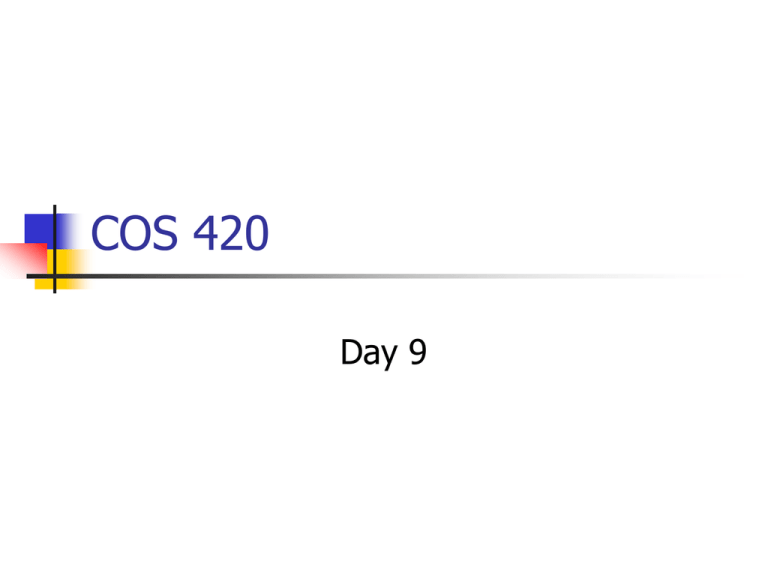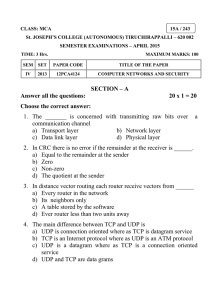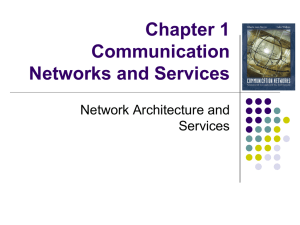COS 420 day 9
advertisement

COS 420 Day 9 Agenda Assignment 2 Corrected I’ll have Assignment 3 ready 2 C’s, 1 D’s and 1 F’s Lots of the same WRONG answers We will go over each question Covers chapters 11-15 Due March 23 Midterm Exam on Feb 27 due Mar 2 Chap 1-12 All short essays More than 10 and should be less than 20 Today we will look at UDP and TCP (RST) PART XII USER DATAGRAM PROTOCOL (UDP) Identifying The Ultimate Destination IP address only specifies a computer Need a way to specify an application program (process) on a computer Unfortunately Application programs can be created and destroyed rapidly Each operating system uses its own identification Specifying An Application Program TCP/IP introduces its own specification Abstract destination point known as protocol port number (positive integer) Each OS determines how to bind protocol port number to specific application program User Datagram Protocol Transport-layer protocol (Layer 4) Connectionless service: provides application programs with ability to send and receive messages Allows multiple, application programs on a single machine to communicate concurrently Same best-effort semantics as IP Message can be delayed, lost, or duplicated Messages can arrive out of order Application accepts full responsibility for errors The Added Benefit Of UDP The User Datagram Protocol (UDP) provides an unreliable connectionless delivery service using IP to transport messages between machines. It uses IP to carry messages, but adds the ability to distinguish among multiple destinations within a given host computer. UDP Message Format If UDP CHECKSUM field contains zeroes, receiver does not verify the checksum Port Numbers In A UDP Message SOURCE PORT identifies application on original source computer DESTINATION PORT identifies application on ultimate destination computer Note: IP addresses of source and destination do not appear explicitly in header UDP Header Source & destination ports are 16 bit numbers Length is 16 bits and describes length of datagram (header and data) Source can be set to zero Min is 8 (no data) Max is ? Checksum is 1’s complement over entire datagram and pseudo-header UDP Pseudo-Header Used when computing or verifying a checksum Temporarily prepended to UDP message Contains items from IP header Guarantees that message arrived at correct destination Note: pseudo header is not sent across Internet Contents Of UDP PseudoHeader SOURCE ADDRESS and DESTINATION ADDRESS specify IP address of sending and receiving computers PROTO field type field in IP datagram Pseudo-header and Datagram Position Of UDP In Protocol Stack UDP lies between applications and IP Encapsulation Division Of Duties Between IP and UDP The IP layer is responsible for transferring data between a pair of hosts on an internet, while the UDP layer is responsible for differentiating among multiple sources or destinations within one host. IP header only identifies computer UDP header only identifies application programs Demultiplexing Based On UDP Protocol Port Number Assignment Of UDP Port Numbers Small numbers reserved for specific services Large numbers not reserved Called well-known ports Same interpretation throughout the Internet Used by server software Available to arbitrary application program Used by client software More later in the course Examples Of Assigned UDP Port Numbers Summary User Datagram Protocol (UDP) provides connectionless, best-effort message service UDP message encapsulated in IP datagram for delivery IP identifies destination computer; UDP identifies application on the destination computer UDP uses abstraction known as protocol port numbers PART XIII RELIABLE STREAM TRANSPORT SERVICE (TCP) Transmission Control Protocol Major transport service in the TCP/IP suite Used for most Internet applications (esp. World Wide Web) TCP Characteristics Stream orientation Virtual circuit connection Buffered transfer Unstructured stream Full duplex connection Reliability Providing Reliability Traditional technique: Positive Acknowledgement with Retransmission (PAR) Receiver sends acknowledgement when data arrives Sender starts timer whenever transmitting Sender retransmits if timer expires before acknowledgement arrives Illustration Of Acknowledgements Time moves from top to bottom in the diagram Illustration Of Recovery After Packet Loss The Problem With Simplistic PAR A simple positive acknowledgement protocol wastes a substantial amount of network bandwidth because it must delay sending a new packet until it receives an acknowledgement for the previous packet. Problem is especially severe if network has long latency Solving The Problem Allow multiple packets to be outstanding at any time Still require acknowledgements and retransmission Known as sliding window Illustration Of Sliding Window Window size is fixed As acknowledgement arrives, window moves forward Why Sliding Window Works Because a well-tuned sliding window protocol keeps the network completely saturated with packets, it obtains substantially higher throughput than a simple positive acknowledgement protocol. Illustration Of Sliding Window Layering Of The Three Major Protocols TCP Ports, Connections, And Endpoints Endpoint of communication is application program TCP uses protocol port number to identify application TCP connection between two endpoints identified by four items Sender’s IP address Sender’s protocol port number Receiver’s IP address Receiver’s protocol port number An Important Idea About Port Numbers Because TCP identifies a connection by a pair of endpoints, a given TCP port number can be shared by multiple connections on the same machine. Example (130.111.67.244:80,130.111.66.240:1380) (130.111.67.244:80,130.111.66.240:1391) Passive And Active Opens Two sides of a connection One side waits for contact A server program Uses TCP’s passive open One side initiates contact A client program Uses TCP’s active open TCP Sliding Window Measured in byte positions Illustration Bytes Bytes Bytes Bytes through 2 are acknowledged 3 through 6 not yet acknowledged 7 though 10 waiting to be sent above 10 lie outside the window and cannot be sent TCP Segment Format HLEN specifies header size (offset of data) in 32-bit words Sequence Number is position in octet steam of the first byte in data Acknowledgment Number is position of incoming data stream of the last byte received + 1 (next expected octet) Window is desired window size Code Bits In The TCP Segment Header Flow Control And TCP Window Receiver controls flow by telling sender size of currently available buffer measured in bytes Called window advertisement Each segment, including data segments, specifies size of window beyond acknowledged byte Window size may be zero (receiver cannot accept additional data at present) Receiver can send additional acknowledgement later when buffer space becomes available TCP Checksum Computation Covers entire segment (header plus data) Required (unlike UDP) Pseudo header included in computation as with UDP TCP Pseudo Header TCP Retransmission Designed for Internet environment Fixed value for timeout will fail Delays on one connection vary over time Delays vary widely between connections Waiting too long introduces unnecessary delay Not waiting long enough wastes network bandwidth with unnecessary retransmission Retransmission strategy must be adaptive Adaptive Retransmission TCP keeps estimate of round-trip time (RTT) on each connection Round-trip estimate derived from observed delay between sending segment and receiving acknowledgement Timeout for retransmission based on current round-trip estimate Difficulties With Adaptive Retransmission The problem is knowing when to retransmit Segments or ACKs can be lost or delayed, making roundtrip estimation difficult or inaccurate Round-trip times vary over several orders of magnitude between different connections Traffic is bursty, so round-trip times fluctuate wildly on a single connection Difficulties With Adaptive Retransmission (continued) Load imposed by a single connection can congest routers or networks Retransmission can cause congestion Because an internet contains diverse network hardware technologies, there may be little or no control for intranetwork congestion Solution: Smoothing Adaptive retransmission schemes keep a statistically smoothed round-trip estimate Smoothing keeps running average from fluctuating wildly, and keeps TCP from overreacting to change Difficulty: choice of smoothing scheme Original Smoothing Scheme Problems With Original Scheme Associating ACKs with transmissions TCP acknowledges receipt of data, not receipt of transmission Assuming ACK corresponds to most recent transmission (a retransmit) can cause instability in round-trip estimate (Cypress syndrome) Assuming ACK corresponds to first transmission can cause unnecessarily long timeout Both assumptions lead to lower throughput Partridge / Karn Scheme Solves the problem of associating ACKs with correct transmission Specifies ignoring round-trip time samples that correspond to retransmissions Separates timeout from round-trip estimate for retransmitted packets Partridge / Karn Scheme (continued) Starts (as usual) with retransmission timer as a function of round-trip estimate Doubles retransmission timer value for each retransmission without changing round-trip estimate Resets retransmission timer to be function of round-trip estimate when ACK arrives for non-retransmitted segment Flow Control And Congestion Receiver advertises window that specifies how many additional bytes it can accept Window size of zero means sender must not send normal data (ACKs and urgent data allowed) Receiver can never decrease window beyond previously advertised point in sequence space Sender chooses effective window smaller than receiver’s advertised window if congestion detected Jacobson / Karels Congestion Control Assumes long delays (packet loss) due to congestion Uses successive retransmissions as measure of congestion Reduces effective window as retransmissions increase Effective window is minimum of receiver’s advertisement and computed quantity known as the congestion window Multiplicative Decrease In steady state (no congestion), the congestion window is equal to the receiver’s window When segment lost (retransmission timer expires), reduce congestion window by half Never reduce congestion window to less than one maximum sized segment Jacobson / Karels Slow Start Used when starting traffic or when recovering from congestion Self-clocking startup to increase transmission rate rapidly as long as no packets are lost When starting traffic, initialize the congestion window to the size of a single maximum sized segment Increase congestion window by size of one segment each time an ACK arrives without retransmission Jacobson / Karels Congestion Avoidance When congestion first occurs, record one-half of last successful congestion window (flightsize) in a threshold variable During recovery, use slow start until congestion window reaches threshold Above threshold, slow down and increase congestion window by one segment per window (even if more than one segment was successfully transmitted in that interval) Jacobson / Karels Congestion Avoidance (continued) Increment window size on each ACK instead of waiting for complete window increase = segment / window Let N be segments per window, or N = congestion window / max segment size so increase = segment / N = (MSS bytes / N) = MSS / (congestion win/MSS) or increase = (MSS*MSS)/congestion win Changes In Delay Original smoothing scheme tracks the mean but not changes To track changes, compute DIFF = SAMPLE - RTT RTT = RTT + d * DIFF DEV = DEV + d (| DIFF | - DEV) DEV estimates mean deviation d is fraction between 0 and 1 that weights new sample Retransmission timer is weighted average of RTT and DEV: RTO = m * RTT + f *DEV Typically, m = 1 and f = 4 Computing Estimated Deviation Extremely efficient (optimized) implementation possible Scale computation by 2n Use integer arithmetic Choose d to be 1/2n Implement multiplication or division by powers of 2 with shifts Research shows n = 3 works well TCP Round-Trip Estimation Measurement Of Internet Delays For 100 Successive Packets At 1 Second Intervals TCP Round-Trip Estimation For Sampled Internet Delays TCP Details Data flow may be shut down in one direction Connections started reliably, and terminated gracefully Connection established (and terminated) with a 3-way handshake 3-Way Handshake For Connection Startup 3-Way Handshake For Connection Shutdown TCP Finite State Machine TCP Urgent Data Segment with urgent bit set contains pointer to last octet of urgent data Urgent data occupies part of normal sequence space Urgent data can be retransmitted Receiving TCP should deliver urgent data to application ‘‘immediately’’ upon receipt TCP Urgent Data (continued) Two interpretations of standard Out-of-band data interpretation Data mark interpretation Data-Mark Interpretation Of Urgent Data Has become widely accepted Single data stream Urgent pointer marks end of urgent data TCP informs application that urgent data arrived Application receives all data in sequence TCP informs application when end of urgent data reached Data-Mark Interpretation Of Urgent Data (continued) Application Reads all data from one stream Must recognize start of urgent data Must buffer normal data if needed later Urgent data marks read boundary Urgent Data Delivery Receiving application placed in urgent mode Receiving application leaves urgent mode after reading urgent data Receiving application acquires all available urgent data when in urgent mode Fast Retransmit Coarse-grained clock used to implement RTO Typically 300 to 500ms per tick Timer expires up to 1s after segment dropped Fast retransmission Sender uses three duplicate ACKs as trigger Sender retransmits ‘‘early’’ Sender reduces congestion window to half Other TCP Details Silly Window Syndrome (SWS) avoidance Nagle algorithm Delayed ACKs For details, read the text Comparison Of UDP And TCP TCP and UDP lie between applications and IP Otherwise completely different Comparison Of UDP and TCP TCP Vs. UDP Traffic Around 95% of all bytes and around 8595% of all packets on the Internet are transmitted using TCP. Eggert, et. al. CCR Summary Of TCP Major transport service in the Internet Connection oriented Provides end-to-end reliability Uses adaptive retransmission Includes facilities for flow control and congestion avoidance Uses 3-way handshake for connection startup and shutdown






